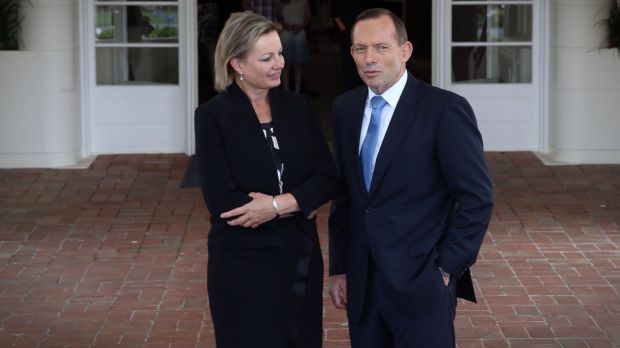
Sussan Ley with Prime Minister Tony Abbott. Photo: Andrew Meares
The new Health Minister Sussan Ley was thrust into the spotlight over the New Year period as she tried to cope with the shemozzle that was her inheritance from the Prime Minister and her predecessor, Peter Dutton.
She cancelled the immediate implementation of the cut to the Medicare rebate and promised more consultation, while sticking to the company line on the general policy on reining in health costs.

The Abbott government needs fresh blood like Kelly O’Dwyer. Photo: Arsineh Houspian
Her performance, cutting short her holidays to front the media, was nothing marvellous but it was fresh and engaging. In other words it was just what this federal government needs a lot more of. The government boasts a stack of experienced ministers who lack the characteristics Ley appears to have. Too many of them are bland, boring and/or wooden.
Ley, the member for Farrer, based in Albury with a mixed background as an air-traffic controller, farmer and public servant, may well turn out to be one of the bright spots for the government in 2015. She is genuine new blood at the higher level and might even bring about some renewal in the government, at least in image if not in substance.
This distinction between reshuffle, renewal and new blood is an important one. The words are being tossed around loosely at the moment. We read just this week, for instance, that several large federal government departments are presently looking for “new blood and fresh ideas at the elite management tier”. While at the ACT level, Chief Minister Andrew Barr welcomed new minister, Yvette Berry, as a “sign of renewal” of his ministry.
Ley occupies her new position because of the Cabinet reshuffle in December by Tony Abbott, which also elevated Josh Frydenberg to Assistant Treasurer, replacing Arthur Sinodinos, who was tainted by political scandal at ICAC. Ley was promoted from Assistant Education Minister. The music stopped at Health for Ley because Scott Morrison moved to Social Services to replace Kevin Andrews who moved to Defence to replace David Johnston who was dropped from the ministry altogether. Dutton moved to Immigration to replace Morrison.
In other words Abbott engaged in a classic reshuffle in which some senior ministers received new jobs but not much new blood was injected into the Cabinet. It was not a serious effort at renewal. He shuffled the existing deck of cards but didn’t introduce many new ones at the senior level.
Even at the junior level there wasn’t very much movement. Senator Simon Birmingham replaced Ley as the Assistant Education Minister. Brett Mason was dropped as a Parliamentary Secretary, apparently because of internal Queensland Liberal National Party politics rather than ability, leaving poor Johnston as the single casualty because of alleged weak performance. Clearly it was not a ministerial performance review or a serious effort to inject new blood into the Cabinet and the ministry.
This was rather a reshuffle that moved some senior ministers from the portfolios they had spent 15 months administering and getting to know. Most of them had also been shadow ministers in these portfolios while in Opposition. As such there were hidden costs to the reshuffle because a lot of experience was being thrown away. Andrews, for instance, had spent years getting to know the sector and thinking through what his approach to Social Services as going to be and now, after less than half a term in office he is no longer minister. The benefits needed to match these costs to make the exercise worthwhile.
The main purpose of this exercise was to help dig the government out of the hole it had dug for itself during 2014. It relied upon a projection of colour and movement rather than substance. That is, it was primarily for external consumption.
Shuffling the ministerial deck can sometimes produce improved government performance. The new ministers might just click in their new portfolios in some inexplicable way. They may even become a perfect match. The whole exercise might produce new energy in the Cabinet. It may lead the way to changes in policy under the guise of the new minister putting his or her own stamp on the portfolio.
But this assumes that the central control of government policy by Abbott and his Treasurer Joe Hockey allows room for flexibility by individual ministers. There has been little sign of this so far. Ley will have to work within these tight constraints in Health.
The limited renewal of the Cabinet and ministry embodied in the December reshuffle is characteristic of Abbott’s approach. He entered government in September 2013 loudly trumpeting the fact that his government would be a continuation of the John Howard era. Therefore he stuck with those who had served as Howard ministers. He elevated little new blood when he came to government and he has compounded this error by his very cautious mid-term reshuffle.
One aspect of his first Cabinet was the almost complete absence of women with only Foreign Minister Julie Bishop among the 20 Cabinet ministers. Somewhat ironically Bishop has been one of the better performers, perhaps the best. It would be equally ironic if the second woman, Ley, turns out to be more successful than the old hands.
Lack of diversity is part of the Cabinet’s problem but it is not the only one however. This means that even if Ley turns out to be successful Abbott will probably need a second Cabinet reshuffle by the end of the year as the 2016 election looms.
If this happens then highly regarded newcomers like Frydenberg, Birmingham and new parliamentary secretary, Kelly O’Dwyer, may be promoted again. The Cabinet as a whole needs to be fresher and more engaging.
John Warhurst is an Emeritus Professor of Political Science at the Australian National University
